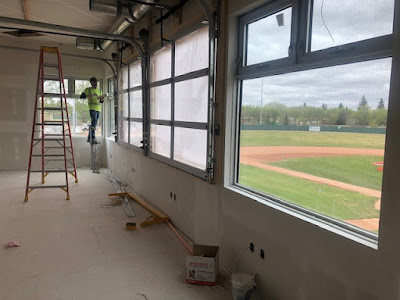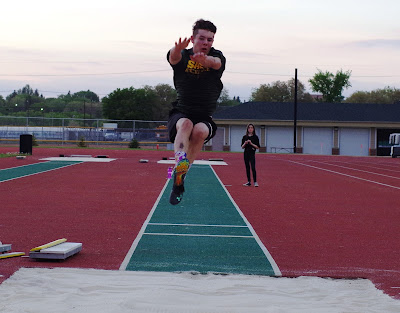By Darren
Steinke
Gordie Howe Sports Complex
 |
| The Multi-sport Centre is nearing completion. |
The
Multi-sport Centre is slated to open for use by users in early July. On the
building’s east side, it will serve all the stadium requirements to allow
Cairns Field to be an elite level amateur baseball facility with the capacity
to seat 2,500.
On the building’s west side, the Multi-sport Centre will serve the Track and Field Track, which is converted into the Clarence Downey Speed Skating Oval for the winter months. It will feature seating for 1,850, which can be expanded to 3,500 with temporary seating.
The Track
and Field Track facility opened in 2019 bringing track and field competitions
to the Gordie Howe Sports Complex grounds for the first time ever.
“I know that the athletes are excited, and they were really
excited about the track,” said Johnny Marciniuk, who is the Operations Manager
for the Gordie Howe Sports Complex. “It is level two certified track, which is
top notch for this country.
“Now, we are going to pair up the building with that track. We’ve had the track for two years. Now, we are going to give all the amenities.
“You’ll have your nice change rooms, viewing areas, bleachers, concessions and all those things that will make the experience that much better.”
 |
| The spectator gallery on the west side of the Multi-sport Centre. |
Way back in
the early 1960s, the old grandstand once served the horse racing community as a
horse racing track used to cut through Cairns Field.
“The history of the area was quite interesting,” said
Marciniuk. “Now, we’ll have the wraparound building that wraps right around
Cairns.
“We have a viewing area that is indoors and heated up on the
second floor. Basically, everybody will be watching speed skating in comfort,
and track and field will have that same option.”
The
Multi-sport Centre will be light years beyond what existed at the old
grandstand. The Multi-sport Centre will have 20,000 square feet of space on its
two floors.
It will include top rate dressing rooms, officials’ rooms, lockers, multi-purpose meeting room, first aid amenities, concession and public washrooms. The building will also have announcer booths and press box areas on either side to allow competition day officials to run events.
There will be an exterior spectator covered viewing area on the Cairns Field side and an indoor spectator viewing area overlooking the Track and Field Track and the Clarence Downey Speed Skating Oval on the west side.
 |
| The announcer’s booth on the east side of the Multi-sport Centre. |
“It is just so interesting to see how the area changes,” said
Marciniuk. “We have the same quality dressing rooms (at the Multi-sport Centre)
that we have at Saskatoon Minor Football Field.
“We have rubber flooring there for safety for the cleats and
skates. Cleats on the baseball side and skates on the speed skating side. We
like to think that we raised the bar here for athletics in this area.
“We’re looking forward to having everybody use it and seeing
those smiles on faces.”
The completion of the Multi-sport Centre will allow the baseball, track and field and speed skating communities to host various national championships and national competitions in their respective sports.
“There are lots of opportunities out there,” said Marciniuk.
“Everybody is talking about championships that they want to bid (for).
“Sports tourism here in Saskatoon is going to support all
our sport groups and their bids. They want to get people into this community,
and we want as the Gordie Howe Sports Complex to get people into our facility.
Those facilities are going to be top notch.”
 |
| One of the dressing rooms inside the Multi-sport Centre. |
Marciniuk said there is a lot more potential to host those
events in baseball, track and field and speed skating with the completed
Multi-sport Centre.
“We have four dressing rooms, a co-ed dressing room (and) an
umpire’s dressing room,” said Marciniuk. “We have meeting rooms that are
available.
“The media box and the scorer’s announcers’ box are top
notch with garage doors that actually will give the open air feel when the
weather is right. With that comes all our other amenities such as our ticket
sales centre, which makes it easy for groups to fund their championships.
“Our concession, our washroom facilities, everything that
goes into a 20,000 square foot (building) will make sure that we have a
first-rate adventure here with our championships.”
Once construction of the Multi-sport Centre is completed,
all the new buildings that were part of the Master Plan for The Complex will be
up and running.
Marciniuk said a few more improvements are still coming before
the final stretch run is completed for the Gordie Howe Sports Complex.
 |
| Pavement is laid on the baseball side at the Multi-sport Centre. |
“We have a 48,000 square foot outdoor turf area for baseball
and softball practices, which is going to be north of our (Indoor) Training
Centre. It is really nice to get all the bricks and mortar in place.
“Once that is all done, we can start looking at beautifying
the site, landscaping and getting all those types of things that make it a great
experience for people from Saskatoon and the greater Saskatoon Area as well as
Western Canada, Canada and world championships we host here. We want people
talking about this place.”
Harrison, Sutherland on fire on
the track
 |
| Michelle Harrison is pursuing a berth in the Summer Olympics. |
This past Friday at a twilight meet, Michelle Harrison and
Savannah Sutherland posted impressive times in the 100-metre hurdles and 400-metre
hurdles respectively.
Harrison, who is a 28-year-old Saskatoon product, ran the
100-metre hurdles in a time of 13.22 seconds. The graduate of Saskatoon’s Evan
Hardy Collegiate and alumna of the University of Saskatchewan Huskies Women’s Track
and Field team has the top 100-metre hurdles time in Canada for all female
competitors in 2021. The next closest time is clocked in at 13.30 seconds.
The time Harrison posted on Friday was her third best ever
in the 100-metre hurdles.
Harrison is aiming to qualify for the upcoming Summer
Olympics, which are slated to run July 23 to August 8.
She is set to race in Windsor and Guelph, Ont., on Saturday and Wednesday, June 16 respectively and will take part in competitions in Montreal on June 26 and 29.
 |
| Savannah Sutherland has set two provincial records. |
Sutherland’s time tops all under-20 female athletes in Canada
this year and ranks fifth outright amongst all Canadian women in 2021.
As of the end of the night this past Friday, Sutherland had posted the
seventh fastest time in the world in 400-metre hurdles for under-20 female
athletes.
She surpassed the under-20 world championship standard in
the 400-metre hurdles. On May 28, Sutherland surpassed the under-20 world
championship standard in the 200-metre hurdles, when she ran that event in a
provincial record time of 24.17 seconds at another twilight meet at the Track
and Field Track.
Sutherland, who is a member of the Saskatoon Track Club, has
committed to join the University of Michigan Wolverines Women’s Track and Field
team in the NCAA Division I ranks starting with the 2021-22 campaign.




